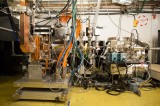
Huge "Thermometer" Takes Temperatures of Tiny Samples
New spectroscopic technique measures heat in itty-bitty volumes that could reveal insights for electronics and energy technology.

Profiling Extreme Beams: Scientists Devise New Diagnostic for Cutting-Edge and Next-Gen Particle Accelerators
The world's cutting-edge particle accelerators are pushing the extremes in high-brightness beams and ultrashort pulses to explore matter in new ways. To optimize their performance - and to prepare for next-generation facilities that will push these extremes further - scientists have devised a new tool that can measure how bright these beams are, even for pulses that last only quadrillionths or even quintillionths of a second.

Water, Water, Everywhere, but How Does It Flow?
Scientists use new X-ray technique to see how water moves at the molecular level.

Nanodiamonds Are Forever
Argonne researchers have created a self-generating, very-low-friction dry lubricant that lasts so long it could almost be confused with forever.

Taking the Stress out of Residual Stress Mapping
Researchers from the University of Virginia are using neutrons to explore fundamental work in residual stress mapping that promises more precise science down the road for Oak Ridge National Laboratory and similar facilities around the world. The UVA team's research will provide insight into the accuracy of residual stress mapping measurements in such materials when the neutron beam must travel large distances through the sample.

Tau-Tolly Microtubular!
Structural model of physiological tau-microtubule interactions sheds light on neurological diseases that correlate with their disruption

NASA Spacecraft Finds New Type of Magnetic Explosion
Four NASA spacecraft have observed magnetic reconnection in a turbulent region of the Earth's outer atmosphere known as the magnetosheath, the planet's first line of defense against the intensity of solar wind. The new insights could help us understand how such phenomena affect Earth's atmosphere.

APS-CNM Users Meeting Helps Scientists Plan for an Even Brighter Future
The Advanced Photon Source and Center for Nanoscale Materials will host the APS-CNM Users Meeting to be held at Argonne from May 7 to 10.
20230510101121.png&width=160&height=110)
Revealing the Mysteries of Superconductors: Ames Lab's New Scope Takes a Closer Look
The U.S. Department of Energy's Ames Laboratory has successfully demonstrated that a new type of optical magnetometer, the NV magnetoscope, can map a unique feature of superconductive materials that along with zero resistance defines the superconductivity itself.

The Weak Side of the Proton
A new result from the Q-weak experiment at the Department of Energy's Thomas Jefferson National Accelerator Facility provides a precision test of the weak force, one of four fundamental forces in nature. This result, published recently in Nature, also constrains possibilities for new particles and forces beyond our present knowledge.

SLAC's X-ray Laser Opens New View on Proteins Related to Alzheimer's Disease
An international research team has come up with a new method with potential for revealing the structure of individual amyloid fibrils with powerful beams of X-ray laser light.

Powerful Hurricanes Strengthen Faster Now Than 30 Years Ago
Hurricanes that intensify rapidly - a characteristic of almost all powerful hurricanes - do so more strongly and quickly now than they did 30 years ago, according to a study published recently in Geophysical Research Letters. The phenomenon is due largely to a climate cycle known as the Atlantic Multidecadal Oscillation.

Better Cleaning In Cold? Researchers Explore Ways to Enhance Detergent Performance In Low Temperature Washing
Research that explores new ways for laundry detergents to improve their cleaning performance in lower wash temperatures was honored with the American Cleaning Institute (ACI) Distinguished Paper Award, recognizing the most outstanding research to appear in 2017 in the Journal of Surfactants and Detergents.

SimEarth
Argonne joins its sister national laboratories in powering a new earth modeling system with supercomputers. The system features weather-scale resolution and can help researchers anticipate decadal-scale changes that could influence the U.S. energy sector in years to come.

Magnetized Plasmas That "Twist Light" Can Produce Powerful Microscopes and More
A non-twisting laser beam moving through magnetized plasma turns into an optical vortex that traps, rotates, and controls microscopic particles, opening new frontiers in imaging.

Design for Magnetoelectric Device May Improve Your Memory
Conventional memory devices use transistors and rely on electric fields to store and read out information. An alternative approach uses magnetic fields, and a promising version relies on the magnetoelectric effect which allows an electric field to switch the magnetic properties of the devices. Existing devices, however, tend to require large magnetic and electric fields. One potential solution is a new switching element made from chromia. The researchers report their findings in Applied Physics Letters.

Whistling While You Work: Fusion Scientists Find Inspiration in Atmospheric Whistles
Just like lightning, fusion plasmas contain odd electromagnetic whistler waves that could control destructive electrons in fusion reactors.

A Potentially Cheap, Efficient and Eco-Friendly System for Purifying Natural Gas
Fundamental researchers have proposed a novel two-part system for separating impurities from natural gas in the Journal of Renewable and Sustainable Energy. Natural gas primarily contains methane, but impurities in the gaseous mixture need to be removed before the methane can be put into the pipeline. The newly proposed purification system combines two separation methods and, in principle, promises to improve performance, reduce costs and diminish ecological side effects compared to benchmark technologies.

Zero Tolerance in Tokamaks: Eliminating Small Instabilities Before They Become Disruptions
Energetic ions and beam heating cause or calm instabilities, depending on the tokamak's magnetic field.

MURR Becomes First Reactor Facility to Join DOE's Isotope Program
DOE and MURR partner to ensure scientists have access to essential research isotopes.

Natural Gas Prices, Not 'War On Coal,' Were Key to Coal Power Decline
Steep declines in the use of coal for power generation over the past decade were caused largely by less expensive natural gas and the availability of wind energy - not by environmental regulations.

Chemists Develop MRI-Like Technique to Detect What Ails Batteries
A team of chemists has developed an MRI-based technique that can quickly diagnose what ails certain types of batteries--from determining how much charge remains to detecting internal defects--without opening them up.

Solar Powered Sea Slugs Shed Light on Search for Perpetual Green Energy
In an amazing achievement akin to adding solar panels to your body, a Northeast sea slug sucks raw materials from algae to provide its lifetime supply of solar-powered energy, according to a study by Rutgers University-New Brunswick and other scientists.

Ultrafast Atomic Snapshots Reveal Energy Flow in Superconductor
A team including SLAC researchers has measured the intricate interactions between atomic nuclei and electrons that are key to understanding intriguing materials properties, such as high-temperature superconductivity.

S&T Researchers Co-Author First Industry-Wide Report on Sustainable Jet Fuel Emissions
The National Academies of Sciences, Engineering, and Medicine Transportation Research Board has released a flagship report on the air quality impacts of sustainable alternative jet fuel (SAJF) emissions. The report is based in part on reviews by Missouri University of Science and Technology faculty Dr. Philip D. Whitefield, chair and professor of chemistry and director of the Center for Research in Energy and Environment (CREE), and Dr. Donald E. Hagen, professor emeritus of physics.
